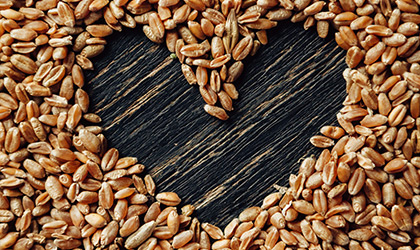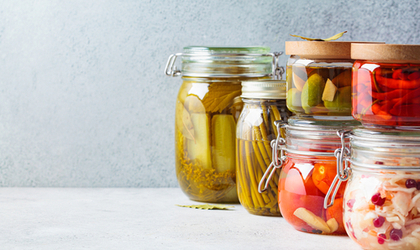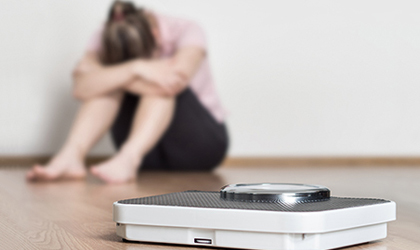
Most of us are familiar with the ‘glucose rollercoaster’. It’s a ride that often sees our blood sugar skyrocket after carb-heavy meals and snacks and drop to breath-taking lows soon after. And these ups and downs come at a cost, affecting all aspects of our health and wellbeing, including mood, energy, focus, and weight.
Although we can’t evade the glucose rollercoaster entirely, we can learn to eat in a way that will help support more balanced blood sugar levels. One tool that can be helpful is the glycaemic index (GI).
What is GI?
The term ‘GI’ was once reserved for individuals with diabetes. Now, it’s widely used as a guide for anyone looking to support their blood sugar levels, making it an extremely useful resource.
The total amount of carbohydrates you eat at a meal or in a snack determines what your blood sugar levels do throughout the day. The GI is a simple rating system that measures how quickly carbohydrate-containing foods affect your blood sugar level when eaten on their own.
Low-GI foods tend to break down more slowly, meaning they’re less likely to cause a rapid increase in blood sugar levels. High-GI foods, on the other hand, are broken down quickly and lead to an almost immediate spike in glucose.
Understanding carbohydrates
Awareness of the different types of carbohydrates and the effect they have on your blood sugar levels can be step one to supporting balanced blood sugar levels.
Simple carbohydrates
Carbs comprise sugar molecules. But not all carbs are created equal. Simple carbs are made up of easy-to-digest sugars, which are naturally occurring – in fruit, for instance – or refined, processed foods, like baked goods or fizzy drinks.
Complex carbohydrates
Complex carbs, on the other hand, contain longer chains of sugar molecules and are found in legumes, vegetables, and whole grains. Complex carbs have the additional bonus of fibre, which slows the absorption of glucose and reduces a blood sugar spike.
What is starch?
Starch is a carb that comprises two types of molecules: amylopectin and amylose.
Starch and blood sugar
The different molecules within starch have a direct effect on GI levels; Amylose – found in kidney beans, lentils, and quinoa – absorbs less water, which slows the rate of digestion and lowers GI. Amylopectin, contrastingly, absorbs more water, increasing digestion and GI. Bagels, crackers, and cookies contain amylopectin.
Low GI diet plan
Choosing healthier carbohydrates with a lower GI will have a more positive effect on your overall blood sugar levels – and that will lead to better health outcomes. The GI values are often broken down into three ranges: low, moderate and high.
Low glycaemic index foods (GI of 55 or less)
-
Steel-cut oats
-
Beans
-
Lentils
-
Legumes
Medium GI foods (GI of 56 to 69)
-
Couscous
-
Corn
-
Sweet potatoes
-
Bananas
High GI foods (GI of 70 and above)
-
White bread
-
Rice cakes
-
Packaged cereals
-
Baked goods
Why should you eat low GI foods?
Scientific research tells us that GI can have a far-reaching impact on health. A low GI diet has been associated with weight loss management, appetite control, and lower blood sugar levels after eating (1).
Low GI food swaps
Making healthier swaps to lower GI foods is one of the best things you can do for your blood sugar levels.
-
White bread: Wholegrain, seedy bread
-
Instant oats: Traditional steel-cut oats
-
Regular potatoes: Sweet potatoes
-
Jasmine rice: Brown rice
-
Corn: Leafy green vegetables
-
Crisps: Nuts
What else affects GI?
The carbohydrate content of food isn’t the only thing that influences GI. A number of other factors are at play.
-
Food processing: the more processed a food, the higher its GI
-
Ripeness: the riper the fruit, the higher its GI
-
Cooking method: the longer a food is cooked, the faster its sugars are absorbed, increasing the GI
-
Fat and protein content: fat and protein lower the GI of food
Is the glycaemic index accurate?
Unfortunately, the glycaemic index isn’t nutritional gospel. Sometimes it can be misleading. Foods with a high GI aren’t necessarily unhealthy. Likewise, not all foods with a low GI are healthy. Take watermelon, for instance, a high-GI food, compared to chocolate cake, which has a lower GI value, so this is something to keep in mind.
Find out more
While the glycaemic index isn’t perfect, it’s a useful tool to help you make better food choices that will help support more balanced blood sugar levels. For more information on managing blood sugar levels, please reach out to one of our expert Nutrition Advisors via email, phone, or Live Chat or alternatively find more nutrition information on our Blog.
Call: 01892 352927
Email: nutrition@naturesbest.co.uk
Write: Nature’s Best Ltd. Century Place, Tunbridge Wells, Kent, TN2 3BE
References:
-
Ebbeling CB. et al., Effects of dietary composition on energy expenditure during weight-loss maintenance. JAMA. 2012;307(24): 2627-34.
Liu AG. et al., Reducing the glycemic index or carbohydrate content of mixed meals reduces postprandial glycemia and insulinemia over the entire day but does not affect satiety. Diabetes Care. 2012;35 (8):1633-7.
You Might Also Like

Olivia
Olivia Salter has always been an avid health nut. After graduating from the University of Bristol, she began working for a nutritional consultancy where she discovered her passion for all things wellness-related. There, she executed much of the company’s content marketing strategy and found her niche in health writing, publishing articles in Women’s Health, Mind Body Green, Thrive and Psychologies.
View More



